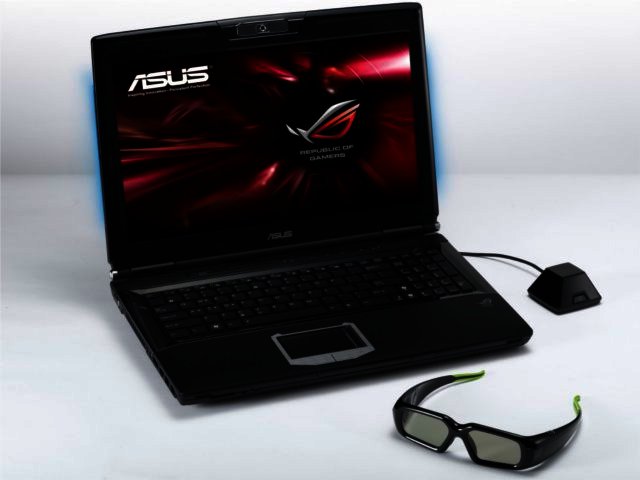Gaming notebooks have always been regarded as questionable entities within the mobile market. Often manufacturers have failed to marry the best of portability and gaming machismo by simply developing expensive machines featuring underperforming graphical setups and poor battery life. This is a trend that has simply been perpetuated over time as gaming and notebook technology has evolved. Now that Nvidia has released its stereoscopic 3D gaming technology, a number of manufacturers are jumping on the bandwagon by delivering gaming notebooks which give the owner the opportunity to take their 3D notebooks on the road.
Here the machine in question is Asus’ G51J gaming notebook - an impressive unit with regards to the weight of its specifications. As a recent addition to the company’s Republic of Gamers (ROG) product line, it sports an Intel Core i7 720QM processor which runs at a stock frequency of 1.6 GHz, 4GB of RAM, dual 320GB hard drives, a 15.6 inch LED lit HD display, HDMI and eSATA ports and WLAN 802.11 b/g/n support.
In addition it also features Nvidia’s GeForce GTX260 which comes equipped with 1GB of VRAM and is capable of supporting 3D gaming and video applications.
It is also important to note that the G51J is available is a variety of CPU, RAM and other options such as an optional Blu Ray drive. The G51J in our possession, although stacked with features, was by no means the most impressive option currently available. This level of choice simply serves to give gamers who want to take the leap into the notebook market while future proofing for 3D more choice when making a purchase.
3D Vision
Packaged with the machine is a 3D USB IR emitter and a set of wireless IR 3D glasses, required if you want to view games and content in 3D. Overall the system was extremely easy to set up and simply required a quick installation and configuration process.
Pre-installed on the PC is a 3D vision preview pack which gives the user a quick idea, through the use of a video, just what the system is capable of.
At this point we moved onto game testing with Call of Duty: Modern Warfare 2. This is where the G51J really stood out, proving that 3D gaming is not just a novelty but rather a view into the future of the industry. Throughout the single player campaign the machine was able to produce clear imagery on 4X anti aliasing with full video specifications.
Supported titles, it appears, have been well adjusted by the developers and Nvidia to allow for smooth and engrossing gameplay. 3D video support however was somewhat less seamless and resulted in a grainy feel to the content which required us to strain in order to keep the picture in focus. Unfortunately Nvidia''s 3D Vision technology i currently limited to supported video content and a list of roughly 400 certified games. Although this list is growing it is a limitation for the G51J.
Build quality
Physically speaking the G51J is clearly aimed at the gaming market and features an attractive gloss blue finish with bevelled edges and LED lights which line the edge of the screen. The touchpad is lined with brushed steel and it features a raised keyboard with key separation.
Overall the G51J has a robust feel to it and, although heavy, gives the appearance of having the solid overall build quality that Asus is known for in its notebook range.
Conclusion
Although the Asus G51J is certainly one of the more impressive gaming notebooks we’ve tested recently the question why an individual would ever need such a machine looms heavily over its head. PC gamers often boast the fact that their machines are constantly upgradable and so have an edge over consoles with regards to extended lifetime.
What we find in the gaming notebook market are essentially ‘PC consoles’ where the purchaser is locked into a setup, at a greater price, for the sake of portability. Nonetheless the G51J performs extremely well within this market. Despite this it still suffers from a common affliction amongst gaming notebooks – poor battery life.
What is most striking about this machine is its ability to demonstrate just how far 3D technology has come in a very short time. This characteristic alone certainly makes the G51J worthwhile for any serious mobile gamer.
Testing:
Cinebench Release 11.5
OpenGL: 22.78 fps
CPU: 2.60 pts
PROS
3D Vision technology, Intel Core i7 CPU, great performance
CONS
3D Vision limited to supported content, poor battery life, no upgrade path





